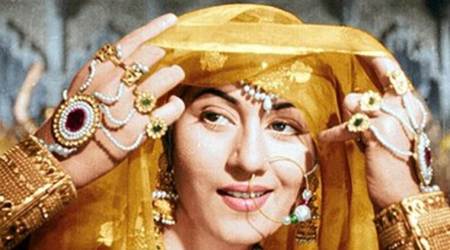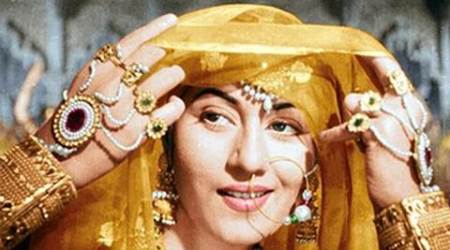 A scene from Feroz Abbas Khan’s Mughal-e-Azam.
A scene from Feroz Abbas Khan’s Mughal-e-Azam.
Minutes after Anarkali looks into Akbar’s exasperated eyes and croons, “Parda nahi jab koi khuda se, bando se parda karna kya” in Feroz Abbas Khan’s Mughal-e-Azam, she freezes. Just then, the dancers around her turn on their heels and create cycles of rhythms with intricate footwork and percussive ghungroos. It’s an intense moment for the audience, with no other sound except that of rhythmically controlled foot-stomping, to think of what just happened. A courtesan just challenged Emperor Jallaluddin Mohammad Akbar.
Choreographer Mayuri Upadhya perches herself in the back of an empty auditorium and observes every little movement on stage during the rehearsal for Abbas’s production, a theatrical tribute to K Asif’s iconic film. On other days, she takes a microphone at Delhi’s JLN stadium and instructs the crew on the smallest of details, a volunteer tells us. She monitors the imposing stillness of Anarkali, played by Pune-based classical singer Priyanka Barve, and the dancers’ feet at work. This two-minute piece didn’t exist in Kathak exponent Lachhu Maharaj’s creation for Madhubala in the film. Maharaj’s Bindadin legacy, under the aegis of the Lucknow gharana, came through in the original.
But Upadhya was categorical about not replicating it. “When I create, I’m very instinctive as the lyrical quality creates images in my head. I can’t lose that instinct or I’ll just be a clone. It had to be a signature Mayuri upadhya piece and yet remain a tribute to what Maharaj created,” says Upadhya, 38, who is the founder of Nritarutya Dance Collective.
Khan’s brief to Upadhya was clear. “I was told what not to do. I was to not take away the classicism of the iconic work, be as pure and authentic, and maintain the standard. Other than that, I had a free hand,” says Upadhya, whose choreography opened PM Narendra Modi’s speech in Germany last year. Chancellor Angela Merkel sat in the audience and saw a representation of India through varied Indian dance forms.
It was Upadhya’s understanding of a slew of art forms — she trained in Bharatanatyam under Indira Kadambi, Kathak under Eshwarpurathi, Odissi under Uday Kumar Shetty, Kalaripayattu under Guru Ranjan Mularatt and contemporary dance from Shobhana Jeyasingh — and her own vocabulary of movement, which prompted the Indian government and later, Khan to pick her as the choreographer. “Every bit in the film is so iconic that every movement on stage needed to be carefully crafted,” says Khan.
For Mughal-e-Azam, which will be staged in Delhi after it had a successful run in Mumbai last year, Upadhya is working with her sister and dancer, Madhuri. The initial plan was to pick dancers from the film industry. But Upadhya wanted dancers who were trained, sculpted and had “Kathak in their system and not just their body”. So she travelled across India to audition and select 100 dancers.
“We needed those who would invest themselves not only physically but also emotionally. I also wanted personalities that could work in teams,” says Upadhya, who has given military-like precision to the choreography during war scenes. For Anarkali, since Barve is singing live, Upadhya had to make sure to strike the balance between her dance movements and voice so that neither was lost.
Growing up in Bangalore as an obese kid, Upadhya didn’t like school and lived in her bubble. In that world, she was always dancing. “I couldn’t dance very well since I was fat, but always enjoyed it,” says Upadhya, who took up dance seriously in college. And now, choreography gives her a high, more than dancing and being under the spotlight. “My body cannot support me for every idea. But seeing those ideas culminate in front of your eyes is better than attention on stage,” says Upadhya, who also does lighting and production for musician and husband Raghu Dixit’s concerts. Mughal-e-Azam will be staged at JLN Stadium from September 9-17, 3 pm and 7 pm. Tickets available on Bookmyshow.com

